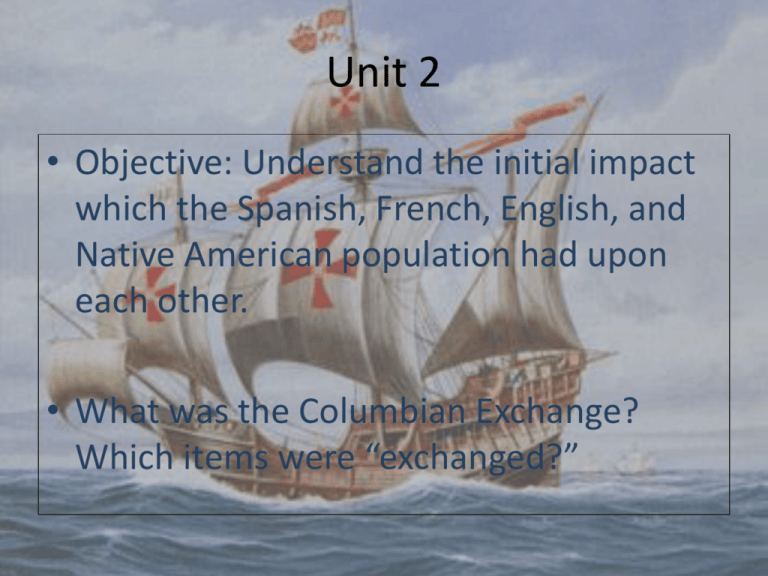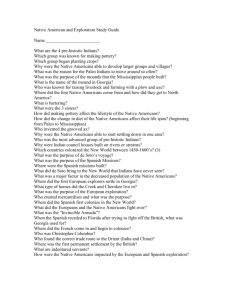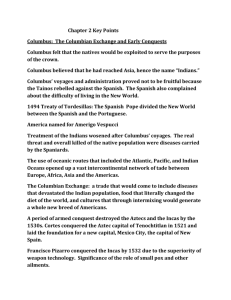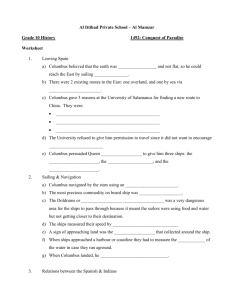
Unit 2
• Objective: Understand the initial impact
which the Spanish, French, English, and
Native American population had upon
each other.
• What was the Columbian Exchange?
Which items were “exchanged?”
Contact
• Contact pre-Columbus?
• The idea of a “New World”?
– Europeans
– Indians
• The idea of a noble savage vs. Savage?
Contact w/ the Spanish
• Conditions in Spain during 15/16th centuries?
• Motivation/Objective of the Spanish and F/I?
• In 1492, King Ferdinand and Queen Isabella announced
their "decision to banish all Jews of both sexes forever from
the precincts of Our realm." Ordered, on pain of death, to
leave within four months, the Jews were permitted to take
their personal belongings, except for gold, silver, coined
money, or jewels. Estimates of the number of Jews
banished generally range from about 165,000 to 400,000.
An estimated 50,000 Jews chose baptism to avoid
expulsion. In his diary Christopher Columbus noted: "In the
same month in which Their Majesties issued the edict that
all Jews should be driven out of the kingdom and its
territories, in the same month they gave me the order to
undertake with sufficient men my expedition of discovery
to the Indies.” (Journal of Historical Review)
Spanish Society
• Crusades, reconquista, inquisition all led to
militant Catholicism/warrior culture intent
upon conquering and upwards class
movement. Consequences? Examples?
• God, Glory, Gold in right order?
• Requerimiento
– Problems w/ the document for Indians?
– Justification for Spanish?
Columbus
• Who, what, when, why?
• Impressions of
Columbus?
• Initial contact and
repercussions.
– Enslavement, death,
anger, attempts to rid
themselves of the
Spanish with tales of
riches elsewhere.
– Zinn reading and NBC
Columbus’ Reaction
• On October 12, 1492, Columbus and his crew arrived at an island in
the Bahamas inhabited by the Arawak Indians. When Columbus and
his sailors came ashore, the Arawaks ran to greet them bringing
food and gifts. Columbus wrote the following in his log...
• “They...brought us parrots and balls of cotton and spears and many
other things, which they exchanged for the glass beads and hawks'
bells. They willingly traded everything they owned...They do not
bear arms, and do not know them, for I showed them a sword, they
took it by the edge and cut themselves out of ignorance...They
would make fine servants...With fifty men we could subjugate them
all and make them do whatever we want.”
• “As soon as I arrived in the Indies, on the first Island which I found, I
took some of the natives by force in order that they might learn and
might give me information of whatever there is in these parts.”
• Los Angeles Unified School District
Reactions
• 1). Is Columbus a hero? Villain? Something
else?
• 2). Genocidal or product of times? Is this an
excuse?
• 3). Impressions of the reactions of the
Indians?
Aftermath of Columbus
• By 1520 Spanish
dominated Caribbean,
but did not see enough
money. King and Queen
decided to go inland in
hopes of riches/power.
• Spanish conquered two
huge empires,
populations with
shocking swiftness.
Columbian Exchange
• Not only physical goods
but also a drastic social
exchange which forever
changed Europe,
Americas, and Africa.
• Interplay between all
three formed America
as we know it today.
The Columbian Biological Exchange
Forms of Biological
Life Going From:
Old World to New World:
New World to Old World:
Diseases:
Smallpox
Measles
Chicken Pox
Malaria
Yellow Fever
Influenza
The Common Cold
Syphilis
Animals:
Horses
Cattle
Pigs
Sheep
Goats
Chickens
Turkeys
Llamas
Alpacas
Guinea Pigs
Plants:
Rice
Wheat
Barley
Oats
Coffee
Sugarcane
Bananas
Melons
Olives
Dandelions
Daisies
Clover
Ragweed
Kentucky Bluegrass
Corn (Maize)
Potatoes (White & Sweet Varieties)
Beans (Snap, Kidney, & Lima Varieties)
Tobacco
Peanuts
Squash
Peppers
Tomatoes
Pumpkins
Pineapples
Cacao (Source of Chocolate)
Chicle (Source of Chewing Gum)
Papayas
| This page was last updated on 12/3/98. | Return to History 111 Supplements | Site Map |
Manioc (Tapioca)
Dr. Harold D. Tallant, Department of History, Georgetown College
Guavas
400 East College Street, Georgetown, KY 40324, (502) 863-8075
Indians with
smallpox
Indians with smallpox
European diseases killed many
millions of Indians during the
initial stages of contact because
they had no immunity to such
epidemic illnesses as influenza,
measles, and plague. Smallpox
was one of the deadliest of these
imported diseases. This Aztec
drawing illustrates smallpox's
impact, from the initial
appearance of skin lesions
through death. Traditional Indian
medical practices were unable to
cure such diseases, and physical
contact between shamans and
patients actually helped to
spread them. (Biblioteca
Medicea Laurenziana)
Copyright © Houghton Mifflin Company. All rights reserved.
Smallpox in Tenochtitlan
• While the Spaniards were in Tlaxcala, a great plague broke out in
Tenochtitlán. It began to spread during the thirteenth month and lasted for
seventy days, striking everywhere in the city and killing a vast number of
our people. Sores erupted in our faces, our breast, our bellies; we were
covered with agonizing sores from head to foot.
The illness was so dreadful that no one could walk or move. The sick were
so utterly helpless that they could only lie on their beds like corpses, unable
to move their limbs or even their heads. They could not lie face down or roll
from one side to the other. If they did move their bodies, they screamed
with pain.
A great many died from this plague, and many others dies of hunger. They
could not get up to search for food, and everyone else was too sick to care
for them, so they starved to death in their beds.
Some people came down with a milder form of the disease; they suffered
less than the others and made a good recovery. But they could not escape
entirely. Their looks were ravaged, for wherever a sore broke out, it gouged
an ugly pockmark in the skin. And a few of the survivors were left
completely blind.
https://facultystaff.richmond.edu/~aholton/121readings_html/aztec_html/i
Ways in Which Europeans Dominated The
Larger Native Population
Disease
Steel
Weapons
Hernando Cortez and Conquest of
Mexico
• Aztec Empire one of
world’s largest and rich
with gold. Ruled by?
• Capital of Tenochtitlan had
population of 200K while
Cortez landed with 508
men, horses, steel armor,
war dogs, cannon, and
support of outlying native
populations.
Hernan Cortes
• Secured Cuba
– Landed in Mexico 1519
– Learned of the great wealth
in the regions interior
• Aztec Empire
– Tenochtitlan
• Magnificent Capital
– Montezuma
• Cortes’ attacking force
Skilled military leader as well as
gifted diplomat
– 500 men, 17 horses, dogs, and
10 cannons
– Convinced Aztec enemies to fight
with him
– 200 miles (Mountains)
Tenochtitlan
Montezuma
• Believed that Cortes was
a god
– Armor
– Offered to share the cites
riches as a tribute
• Wanted more
• Aztec rebellion, 1520
– Stoned Montezuma
– Able to defeat the Spanish
• Not their diseases
• Smallpox and Measles
• Spanish defeated the
Aztecs in 1521 and
creatively renamed the
capital.
• Whet Spanish appetite for
golf.
The Mexican Counterattack, Codex Durán
The Mexican Counterattack, Codex Durán
The differences between European and Native American styles and conceptions of warfare
were often striking. This scene, from the Codex Durán, illustrates a Spanish force besieged by
Aztec warriors. Note the contrast in clothing, for example. For most Indian groups, warfare was
a highly spiritual affair surrounded by ceremony, often involving colorful and fanciful costumes.
The European battle dress, however, bespeaks a very different conception of warfare: practical
and deadly. (Archivo fotografico)
Copyright © Houghton Mifflin Company. All rights reserved.
Other Conquistadors
• Pizarro conquered the Incan Empire with only
168 men because of:
– Disease and division of Incan allegiances
• De Soto’s trip through the southwest looking
for gold, leaving destruction.
• Very quickly greed dominated the invasions
and led to horrible atrocities and few critics.
• Human rights were now more than ever on
the backburner.
Routes of Conquest
De Soto’s Route (1539-43)
Pizarro’s Route (1524-1535)
Bartolome de Las Casas
• “Now Christ wanted his gospel to be preached with
enticements, Gentleness, and all meekness, and pagans
to be led to the truth not by armed forces but by holy
examples, Christian conduct, and the word of God, so
that no opportunity would be offered for blaspheming
the sacred name or hating the true religion because of
the conduct of the preachers. For this is nothing else
than making the coming and passion of Christ useless,
as long as the truth of the gospel is hated before it is
either understood or heard, or as long as innumerable
human beings are slaughtered in a war waged on the
pretext of preaching the gospel and spreading religion”.
• http://justus.anglican.org/resources/bio/203.html
Pope Paul III (Topic: the enslavement and
evangelization of Indians)
1537 A.D.
• We, who, though unworthy, exercise on earth the power of our Lord and seek with
all our might to bring those sheep of His flock who are outside into the fold
committed to our charge, consider, however, that the Indians are truly men and
that they are not only capable of understanding the Catholic Faith but, according to
our information, they desire exceedingly to receive it. Desiring to provide ample
remedy for these evils, We define and declare by these Our letters, or by any
translation thereof signed by any notary public and sealed with the seal of any
ecclesiastical dignitary, to which the same credit shall be given as to the originals,
that, notwithstanding whatever may have been or may be said to the contrary, the
said Indians and all other people who may later be discovered by Christians, are by
no means to be deprived of their liberty or the possession of their property, even
though they be outside the faith of Jesus Christ; and that they may and should,
freely and legitimately, enjoy their liberty and the possession of their property; nor
should they be in any way enslaved; should the contrary happen, it shall be null and
have no effect.
Permanent Colonization
• After the Conquistadores subjugated many
peoples militarily the Spanish used religion to
subjugate them socially, economically.
– St. Augustine in 1565, 1st city in N. America.
• Encomienda system formed early for
protection. Which kinds?
• Encomienda turned to Repartimento after
1550 as rich began to get greedy with help of
Church.
Taos Pueblo
Spanish Colonization Impact
• Small #’s of Indians did convert wholly, some
partially, many resisted privately. Why?
• As priests banned/disrupted traditions,
Pueblo’s became angryrevolt.
• 1680, led by Pope overran the
Pueblos/Missions. 1st and possibly most
successful Indian revolt.
• Led to less harsh Spanish, diffusion of two
cultures for defense/survival from?
Pope’s Pueblo Rebellion
http://www.musnaz.org/Images/Photos/Pic-Kiva_Pueblo.jpg
French Invasion
• Indian Guide: “Missi picoutau amiscou, “The
beaver knows how to make all things to
perfection: It makes kettles, hatchets, swords,
knives, bread; in short, it makes everything.”
Fa. Le Jeune: The Europeans, “...carry this to
such an extent that my host said to me one
day, showing me a very beautiful knife, “The
English have no sense; they give us twenty
knives like this for one beaver skin.”
• Paul Le Jeune, S.J.
Quote
• What does this quote say about the difference
in both cultures and their wants?
• What negative consequences could develop
for the Indians based upon their trade with
the French?
Origins of Trade
• Cartier sailed down St.
Lawrence (1534)
followed by Champlain in
1603 w/ different tactics
than Spanish.
– Algonquin tribe first to
connect/accept French
traders and missionaries.
– Led to conflict with
Iroquois and other tribes.
Combined w/ disease,
Indians were losing on the
arrangement.
Champlain 1603
Cartier 1534
Other French Explorers
• Joliet and Marquette 1st
Euros on Mississippi.
• La Salle 1st to make it go
Gulf of Mexico.
• Tributaries explored/
settled by traders and
Jesuits building
relationships.
“Louisiana”
Joliet/Marquette Route
La Salle’s Route
•
French-Indian Alliance, 1673-1712
by James E. Lewis Jr., Ph. D.
Kalamazoo College
•
During the last quarter of the seventeenth and first half of the eighteenth centuries, the
native peoples of the Great Lakes region and the French in Canada and Louisiana
crafted a complex relationship that would continue to shape native expectations of
European-Indian interactions for decades to come. What the French needed were allies
against the Iroquois and English and trading partners. What the Indians of the pays d'en
haut (the "upper country" around the Great Lakes) needed was protection against the
Iroquois, access to European trade goods, and assistance in mediating the differences
between the tribes, clans, and villages that had been thrown together by the Iroquois
Wars. The alliance--what one historian describes as "the middle ground"--that came
together in the pays d'en haut looked very different from anything seen in European
diplomacy. The French gained influence over their various allies through methods that
were much more in keeping with Indian diplomacy and culture than their own. Holding
the alliance together and making it serve their purposes required the French to meet
the needs of their Indian allies at a great expense of time and effort and in ways that
were entirely alien to their thinking.
The alliance between the French and the Indians in the pays d'en haut was easily
shaken. The French occasionally decided that they no longer needed assistance against
the Iroquois or the English. Or they decided to save money by cutting back on their gift
giving. Or they failed to provide sufficient trade goods at the customary prices. The
alliance was temporarily disrupted whenever a new governor was sent to Canada; he
had to learn what his predecessors had learned about how to manage things. It also
suffered whenever the French decided that they should be able to dominate their
Indian allies, particularly when they attempted to destroy, rather than just chastise,
their opponents within the alliance. And there were also times when the Indians
opposed French mediation efforts or decided that they did not need French protection.
•
•
?’s
• 1). What conditions led to the French
choosing different tactics than the Spanish?
• 2). What similarities do you see with the
French and Spanish?
Jesuits and Indians
“This Land is our Enterprise”
“One World is not big enough”
• Emmanuel Nobrega, S.J. (15171570)
• Differences between French and
Spanish missionaries? P. 125-127
• Fa. Brebeuf and Marquette led
Jesuits to settle with Hurons.
Problems?
– Cultural, illnesses brought,
anti-French feelings, drove
tribes to further violence, etc.
Jesuits
• Relative success because?
– War, disease, goods offered
(Jesuit rings), kindness and
hard work/dedication (Jogues,
Marquette, etc)
• Conversion of population
slow, but successful
– Blessed Kateri Tekakwitha
• Missions became
geographical and figurative
centers for French trading
empire.
Conclusion
• Main areas and reasons for conflict/failures?
– Iroquois Confederacy, fur trade brought societal
ills to the Indians, Jesuits brought divisions in
some communities.
• Main areas and reasons for successes?
– Realized their shortcomings and built long-lasting
relationships with northern Indian tribes while
many times respecting (if not accepting) cultures.
French Quiz
• 1). First Frenchman to sail down the St. Lawrence
• 2). Indian tribe who fought with original French
explorers/Jesuits?
• 3). Which power believed in giving gifts, not “invoking
paternal order?” Spanish/French?
• 4). French commerce centered around this
• 5). French trade centered around which Indian
product? ____________ FIB
• A. Algonquin
D. Fur trade
• B. Gold/silver mines
E. Iroquois
• C. Sommelier
F. Cartier
English Colonization
• Relations with the English tended to be more
violent because:
– English colonial policy at “home”
– Religious fanaticism
– Lack of gold led to land grab and westward
invasion and confronting French.
English Tactics
• Did not intermix with
the native population
• Actual laws against
intermarriage. “Irish
Policy”. Religious
implications as well.
Jamestown
• Disastrous start
– Thoughts of gold disease and starvation
– Only 38 of 150 survived
• John Smith
– Took control of the settlement with help
of Powhatan and Pocahontas.
– “Why take by force what you can have by
love?” –Powhatan
– Accident led to disintegration of
relationship, more settlers and war
despite Rolfe/Pocahontas efforts.
– By 1676 (end of Bacon’s Rebellion),
remaining Powhatan’s settled in first
reservations.
Establishing a Beachhead
• Puritan objectives and
background.
• Colony’s struggles, Squanto
and Massasoit
• 1629 M.B.C. chartered and
conflict erupted with
Pequot.
Winthrop and Puritan Ideology
• “For we must consider that we shall be as a city upon a
hill, the eyes of all people are upon us. So that if we
shall deal falsely with our God in this work we have
undertaken and so cause Him to withdraw His present
help from us, we shall be made a story and byword
throughout the world, we shall open the mouths of
enemies to speak evil of the ways of God and all
professors for God's sake, we shall shame the faces of
many of God's worthy servants, and cause their prayers
to be turned into curses upon us till we be consumed
out of the good land whither we are going.”
• John Winthrop 1630
Pequot War 1637
• Why? Land and trade issues
• “God…laughed at his
Enemies and the Enemies
• Who? Mass. And Conn.
of his People to scorn,
Militias against Pequot nation.
making them as a fiery
• Outcome:
Oven…and filling the
– Bradford’s account of Mystic
place with Dead Bodies.”
River massacre. Treaty of
• “…in little more than one
Hartford ends Pequot nation
and survivors are sold to the
hour, five or six hundred
Indies
of these barbarians were
• Effect: Indian resistance
dismissed from a world
pushed westward and
that was burdened with
colonists take most trade and
them.” Cotton Mather
valuable land.
• Praying towns and oppression
of natives.
• Praying Towns converted
and sheltered
downtrodden Indians, but
also succeeded in
eradicating much of the
native culture: “'Soap and
education are not as
sudden as a massacre,
but they are more deadly
in the long run.'' -Mark
Twain
King Philip’s War 1675
• Massasoit and
Bradford Metacom
vs. Winslow
• Why?
– Land/trade
arrangements
– Excuses of English?
• Trespassing/weapons
charges
• Sassamon’s death/trial
War and Outcome
PSD
•
•
•
•
War
Tribes chose sides, with most
warriors choosing war on own.
Narrangaset allies attacked for
harboring women/children
Great Swamp Fight Outcome P.
136 in text
Mahicans turn on Metacom,
whose men are forced to run
Turner’s Falls episode, Cpt.
Church’s tactics and capture of
Metacom’s family, and death of
Metacom.
The “fight” consisted of lighting the
fortified village of the Narragansetts on
fire, with the inhabitants—men, women,
and children––still inside. The forces from
the United Colonies lost seventy men and
one hundred fifty were wounded in their
attempts to breach the walls before
resorting to the torch. The Narragansetts
lost close to one hundred warriors and an
undetermined number of women and
children (estimates run between three
hundred and one thousand). As such, the
English gave the natives another lesson in
so-called civilized warfare.
– Hawthorne “Young Goodman Brown”:
A Postcolonial Reading
Conclusion
• By end of 17th century French, Spanish, and English
settlers, traders, armies had established
“beachheads” from which they began their
conquests. They had survived hardships, and
revolution because of disease, superior weapons,
and European tactics which all overwhelmed the
native population. From this point forward, the
Indians will never have another opportunity to
remain totally free from the Europeans, but only to
delay the inevitable.
– “Colonial America was established in Indian America”
Calloway
Quiz
• 1). Which three European nations dominated the
invasion of North, Central, and South America?
• 2). The Requerimiento required Indians to
acknowledge who as their lord and superior?
• 3). The ________ Exchange brought new foods to
Europe, and new diseases to Americas.
• 4). Which conquistador conquered the Aztec
empire?
• 5). Which European disease killed the majority of
the native population?
English Quiz
• 1). He served as translator and advisor to the earliest
Pilgrims.
• 2). ______ ‘saved’ John Smith from execution. FIB
• 3). The ________ war was ended with the Mystic River
massacre. FIB
• 4). Former Indian ally to Puritans whom Massachusetts
declared war on for harboring Wampanoag:
• 5). Which Wampanoag chief fought against the New
England colonies?
• A. Narrangasett
D. Squanto
• B. Metacomet
E. Massasoit
• C. Mohicans






